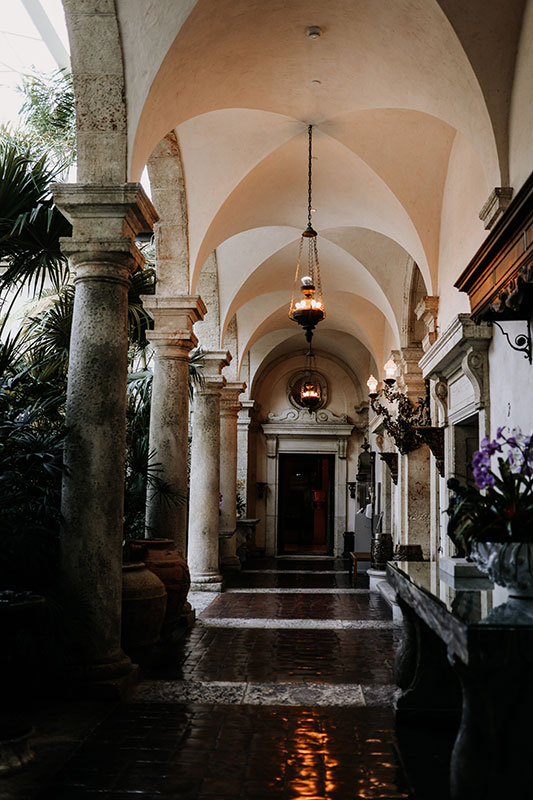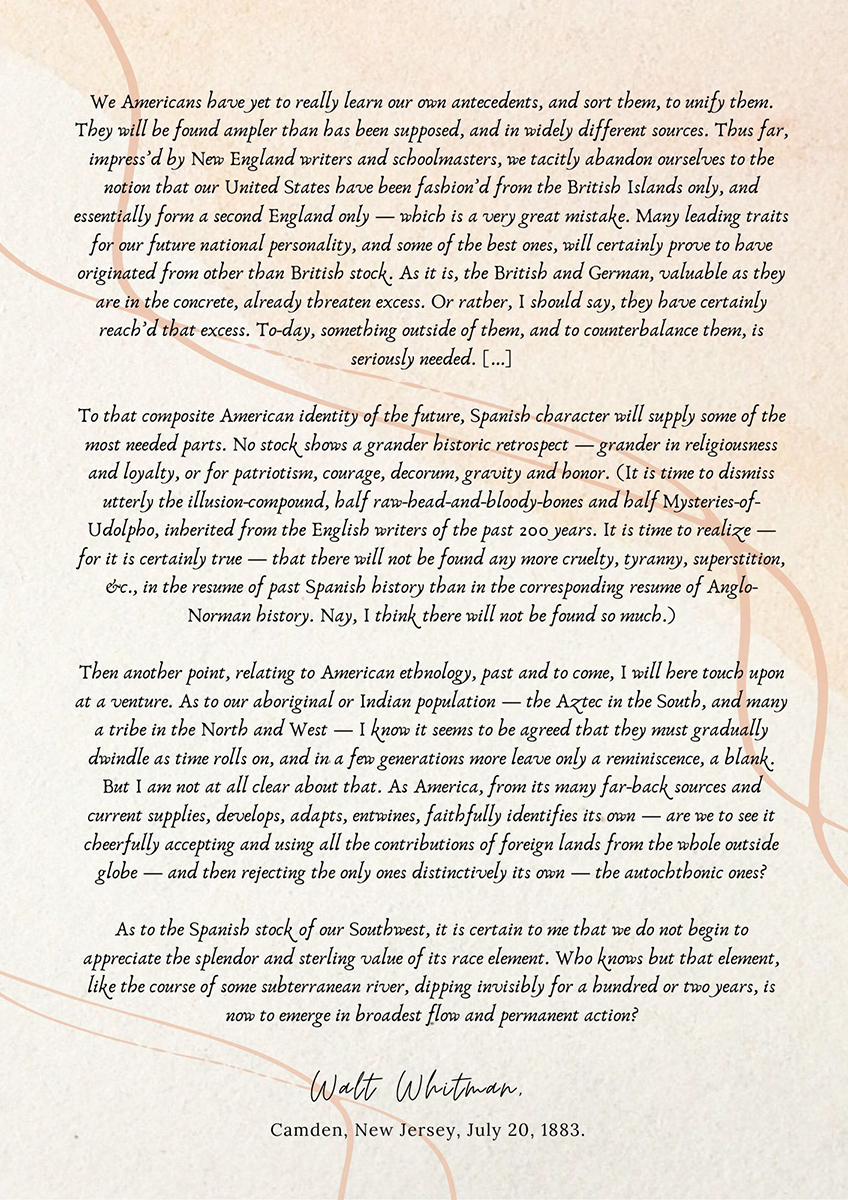THE USA’S HISPANIC HERITAGE

Arcade in Vizcaya Museum and Gardens, Miami, Florida. Photo by Leah Kelley from Pexels.
Forgotten Hispanic History in North American Territory
- The exploration, settlement and colonization of the United States territory began in 1512 from south to north and westward (from Florida to New England and as far as Texas) with Ponce de Leon. (The east-west Lewis & Clark endeavor occurred in 1804.) Furthermore, in 1539, Hernando de Soto was appointed Governor of Florida, exploring the areas of Florida, Georgia, Arkansas, Mississippi, Alabama, Louisiana, and northwest Texas. He discovered the Mississippi River.
- The 1st European settlement on the Atlantic coast was established by Pedro Menéndez de Avilés en 1565 at a place he called San Agustín (St. Augustine, today) in Florida. (The Pilgrims arrived in Jamestown in 1607.)
- The 1st recorded Thanksgiving celebration allegedly occurred in St. Augustine, Florida in 1565. A second recorded such celebration occurred in San Elizario, Texas, when Juan de Oñate observed a Thanksgiving Ceremony in 1598. (Plymouth Rock occurred in 1621.)
- After the U.S. independence from the English in 1776, much of the Southwestern territory remained inhabited by Spanish-speaking people of mestizo (Indian-Spanish) or Spanish ancestry as well as Indigenous peoples who were citizens of Mexico. Many states and cities in this territory were governed by Spain first and Mexico second until the 1800s, such as Alabama, Arizona, Arkansas, California, Colorado, Florida, Louisiana, Mississippi, Montana, Nevada, New Mexico, Texas, Utah.
- The origins of the Hispanic population in the US were firstly those descendants of Spanish settlers and Indigenous American nations in both Florida and the Southern territory who were originally citizens of Mexico before the border was moved: “they didn’t cross the border; the border crossed them.” Hispanic immigration to the U.S. started and increased long after that resulting in Hispanic populations grouped by national origin (Cuban in the southeast; Mexican in the southwest; or Caribbean/Puerto Rican in the south). Today, that is no longer the case.
Thomas Jefferson in the 1700s
Back in 1787, Jefferson acknowledged the Spanish origins of the territory that is now the United States. In his library at Monticello, he kept books in Spanish such as:
1. Historia Natual y moral de las Indias by Fray Juan de Torquemada
2. Four volumes of Don Quijote by Cervantes
3. La Florida by Inca Garcilaso de la Vega
4. Historia de la conquista de México, América Septentrional o Nueva España by Antonio de Soliz y Rivadeneira
In writing to some of the young men in his family, he said,
“Spanish. Bestow great attention on this, and endeavor to acquire an accurate knowledge of it. Our future connections with Spain and Spanish America will render that language a valuable acquisition. The antient history of a great part of America too is written in that language.”
“Apply yourself to the Study of the Spanish language will all the assiduity you can. It and the English covering nearly the whole face of America, they should be well known to every inhabitant, who means to look beyond the limits of his farm.”
“With respect to modern languages, French [is indispensable]. Next to this, the Spanish is most important to an American. Our connection with Spain is already important and will become daily more so. Besides this, the ancient part of American history is written chiefly in Spanish.”
American History & Perspective Today
Unfortunately, the following quote by former president Teddy Roosevelt in 1919, given in a context of international strife, has permeated the U.S. even today:
“In the first place we should insist that if the immigrant who comes here in good faith becomes an American and assimilates himself to us, he shall be treated on an exact equality with everyone else, for it is an outrage to discriminate against any such man because of creed, or birthplace, or origin. But this is predicated upon the man’s becoming in very fact an American, and nothing but an American… There can be no divided allegiance here. Any man who says he is an American, but something else also, isn’t an American at all. We have room for but one flag, the American flag, and this excludes the red flag, which symbolizes all wars against liberty and civilization, just as much as it excludes any foreign flag of a nation to which we are hostile…We have room for but one language here, and that is the English language…and we have room for but one sole loyalty and that is a loyalty to the American people.”
History in general is complex but it behooves us to make an effort to learn its many variables and perspectives in order to sanely assess the present and the future.
The United States has been good to many of us who are immigrants, and we acknowledge the fact that, as any other country with a humans in it, its history will contain both good and bad, happy and sad memories. We owe it to our children to teach it all. Thankfully, progress has been made, albeit somewhat slowly. We are hopeful!
Walt Whitman On Hispanic Heritage (1883)
Read below an excerpt of a letter written by Whitman in 1883 in commemoration of the 333rd anniversary of the founding of Santa Fe, or read it in its entirety HERE.

Earliest Literary Works in the US territory
The first books written in the territory that would later become the United States, written in Spanish, were the following:
- Relación (1542) by Álvar Núñez Cabeza de Vaca: Travesía territorio estadounidense 1528-1537). Vol 1 and 2.
- Descubrimiento de las siete ciudades de Cíbola by Fray Marcos de Niza (possibly written during 1539 on a mission to New Mexico)
- Obra nuevamente compuesta (1571 in Seville) by Bartolomé de Flores, presumably written in Florida.
- Poemario La Florida by Fray Gregorio de Escobedo (escrita hacia fines del siglo XVI e inicios del XVII)
Other Early Historical Works in Spanish:
- Relación de los mártires de La Florida de Luis Jerónimo de Oré y su Relación (c. 1619) [Buy in Spanish | Buy an English Translation]
- Historia de La Florida de Inca Garcilaso de la Vega (1803). [Read in Spanish | Buy an English translation]
- Viage a los Estados-Unidos del Norte de América de Lorenzo de Zavala (1846) [Read in Spanish | Buy an English translation]
Current Hispanic Artists, Poets and Writers
Some writers and poets in the US today are a must in our program of studies, such as:
- Ada Limón, 24th Poet Laureate of the United States
- Alma Flor Ada
- Esmeralda Santiago: When I was Puerto Rican; Cuando era puertoriqueña
- Gladys Roldan-de-Moras, painter
- Judith Ortiz Cofer: Silent Dancing: A Partial Remembrance of a Puerto Rican Childhood
- Julia Alvarez: Before We Were Free; Antes de ser libres; Finding Miracles; En busca de milagros
- Linda Rondstandt, singer
- Los lobos, music band
- Oscar Hijuelos, first Hispanic to win a Pulitzer Prize for Fiction: Our House in the Last World; The Mambo Kings Play Songs of Love
- Pam Muñoz Ryan: Esperanza Raising; Esperanza renace
- Rudolfo Anaya: Bless Me, Ultima; Heart of Aztlán; Tortuga
- Sandra Cisneros: The house on Mango Street; La casa en Mango Street
A more exhaustive list will be available soon!
Read More
The list of the books I’ve read is long. Below are the books that I’ve enjoyed the most about US History:
- América: The Epic Story of Spanish North America, 1493-1898 by Robert Goodwin
- El Norte: The Epic and Forgotten Story of Hispanic North America by Carrie Gibson | El Norte. La epopeya olvidada de la Norteamérica hispana (Spanish Edition) by Carrie Gibson
- Latino Americans: The 500-Year Legacy That Shaped a Nation by Ray Suarez | Latino Americanos: El legado de 500 años que dio forma a una nación by Ray Suarez
- Nuestra América by José Vega
- Our America: A Hispanic History of the United States by Felipe Fernández-Armesto | Nuestra América: Una historia hispana de Estados Unidos (Spanish Edition) by Felipe Fernández-Armesto (Author), Eva Rodríguez Halffter (Translator)
- The Hispanic United States: Deeply Woven into the Nation’s Tapestry by Luis Alberto Ambroggio | Estados Unidos Hispano by Luis Alberto Ambroggio
- The Rediscovery of America. Native Peoples and the Unmaking of U.S. History by Ned Blackhawk
About the Spanish Language in the US:

We're walking an uncharted path when applying Hispanic parameters to our CM educational programs in the United States. But with your input and our research, we con do the jump from the Victorian era at the height of the British Empire to our 21st century Spanish-speaking/bilingual homes and schools!
Trabajamos al alero de un ministerio cristiano sin fines de lucro. Si desea colaborarnos financieramente, puede hacerlo a través de Zeffy, especificando “Educación.” También puede comprar las obras recomendadas en nuestro sitio pinchando los enlaces afiliados a Amazon sin costo adicional para usted. ¡Gracias y que Dios le recompense ricamente!
For now, we gather monetary funding under a Christian non-profit ministry called Messiah Missions. Your financial support is greatly appreciated! You may send an offering via Zeffy. Please earmark it for “Education.” You may buy books we recommend by clicking on the affiliate links on Amazon at no extra cost. Thank you, and may our God richly bless you!


